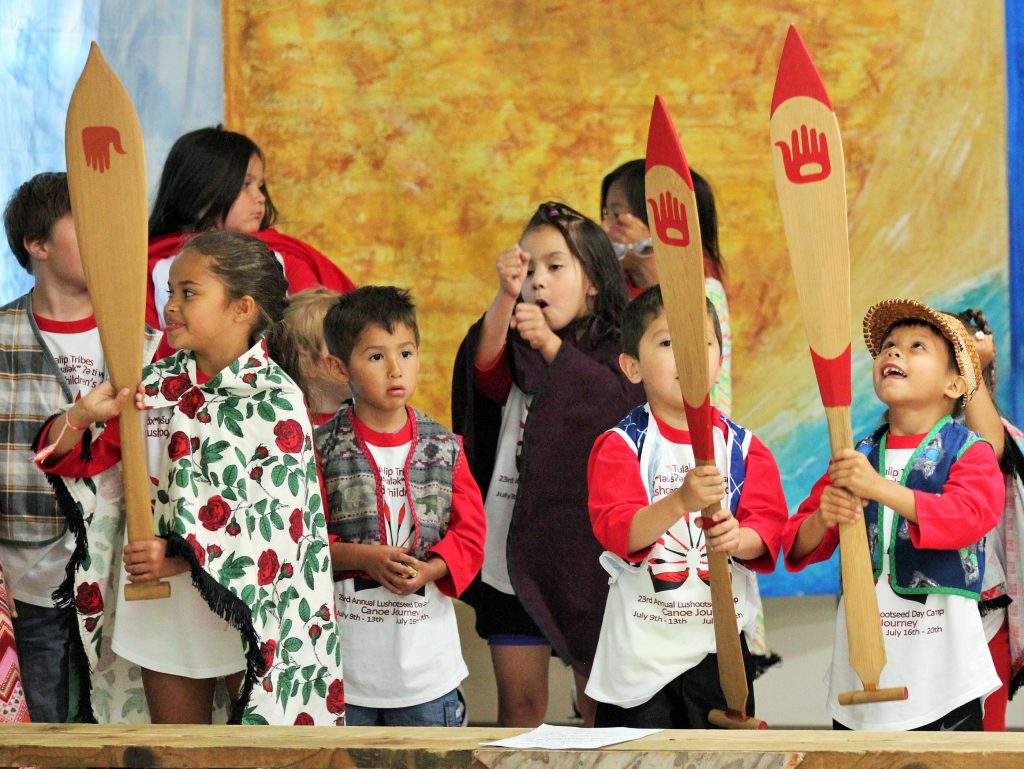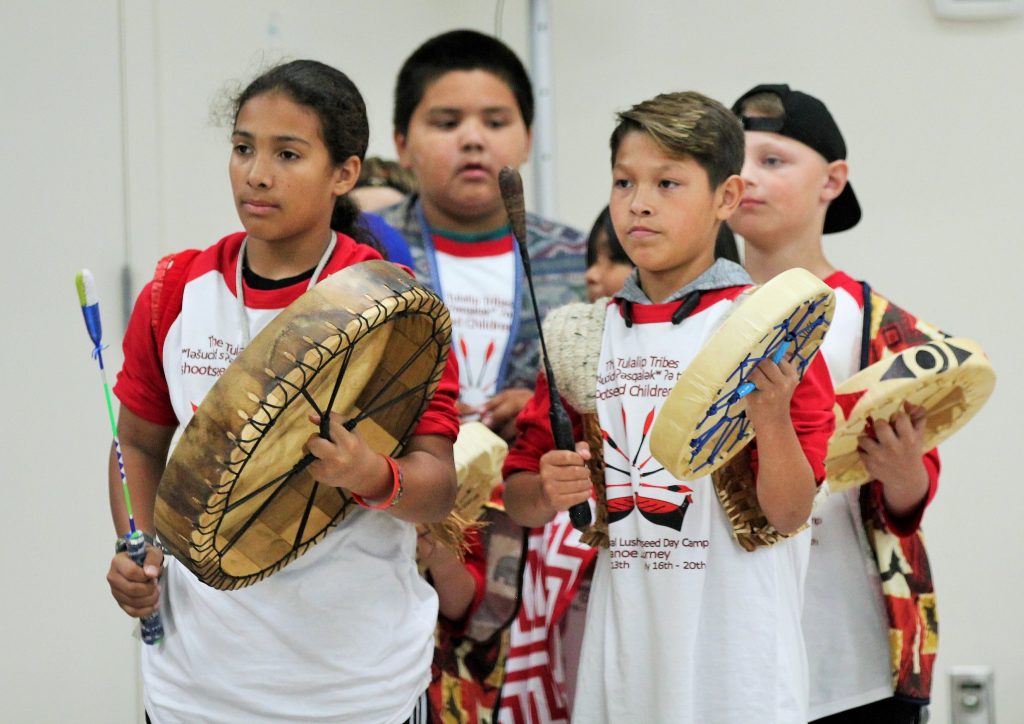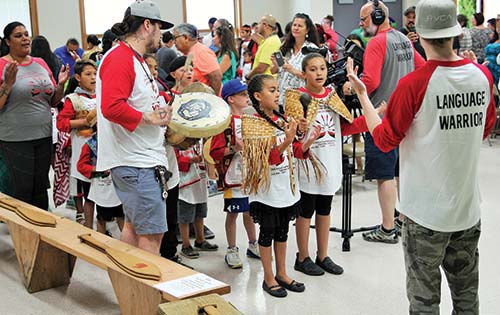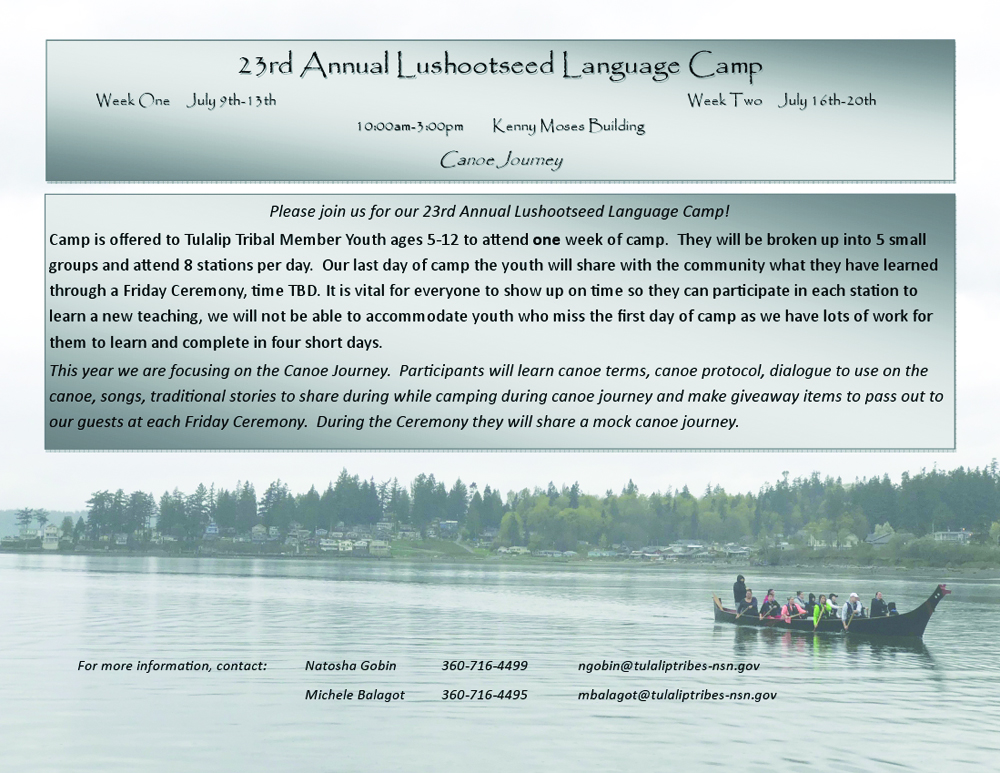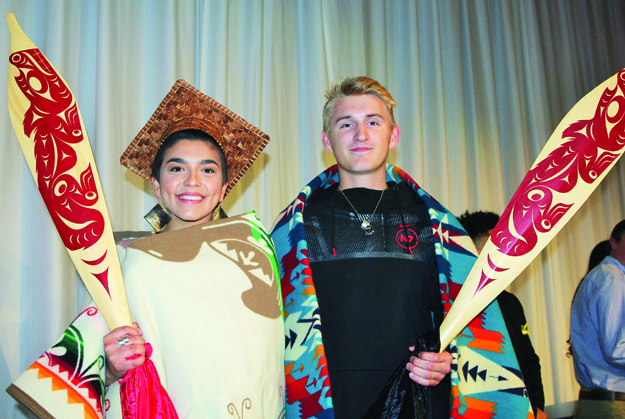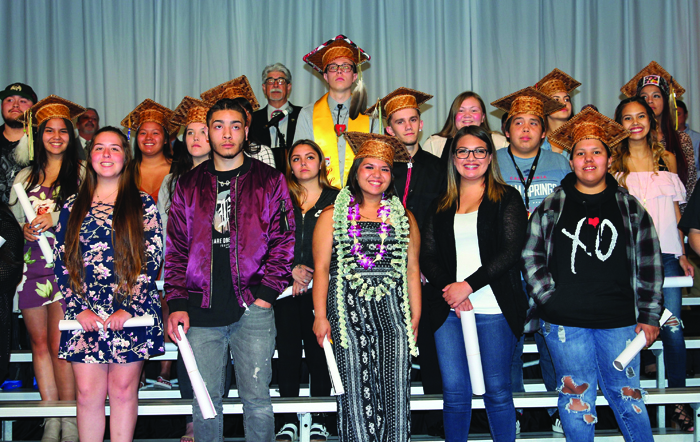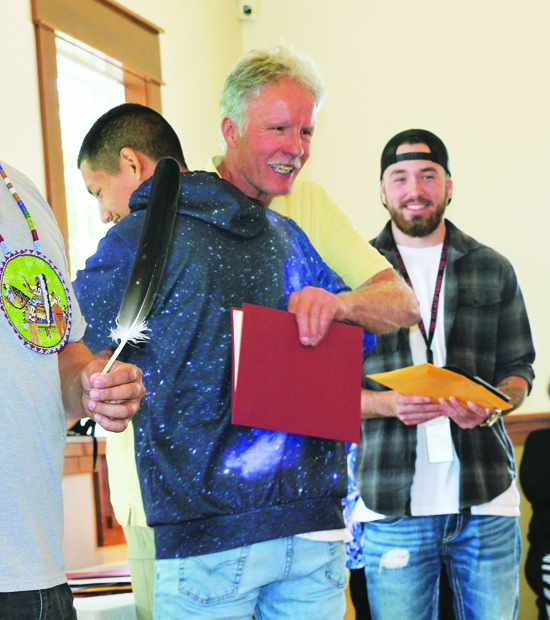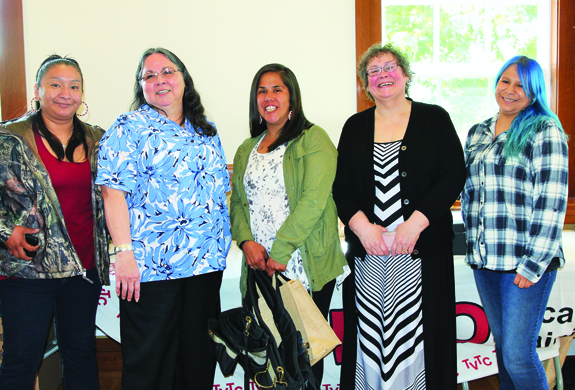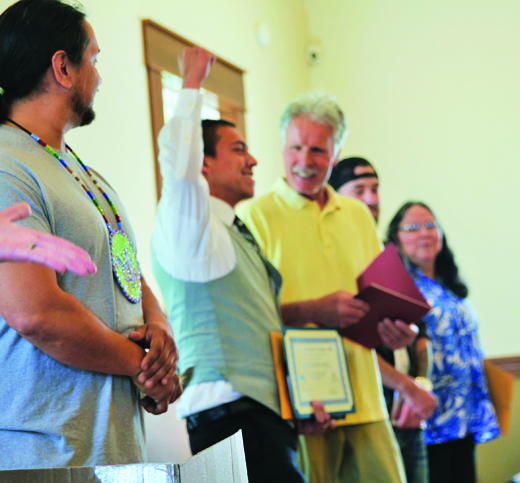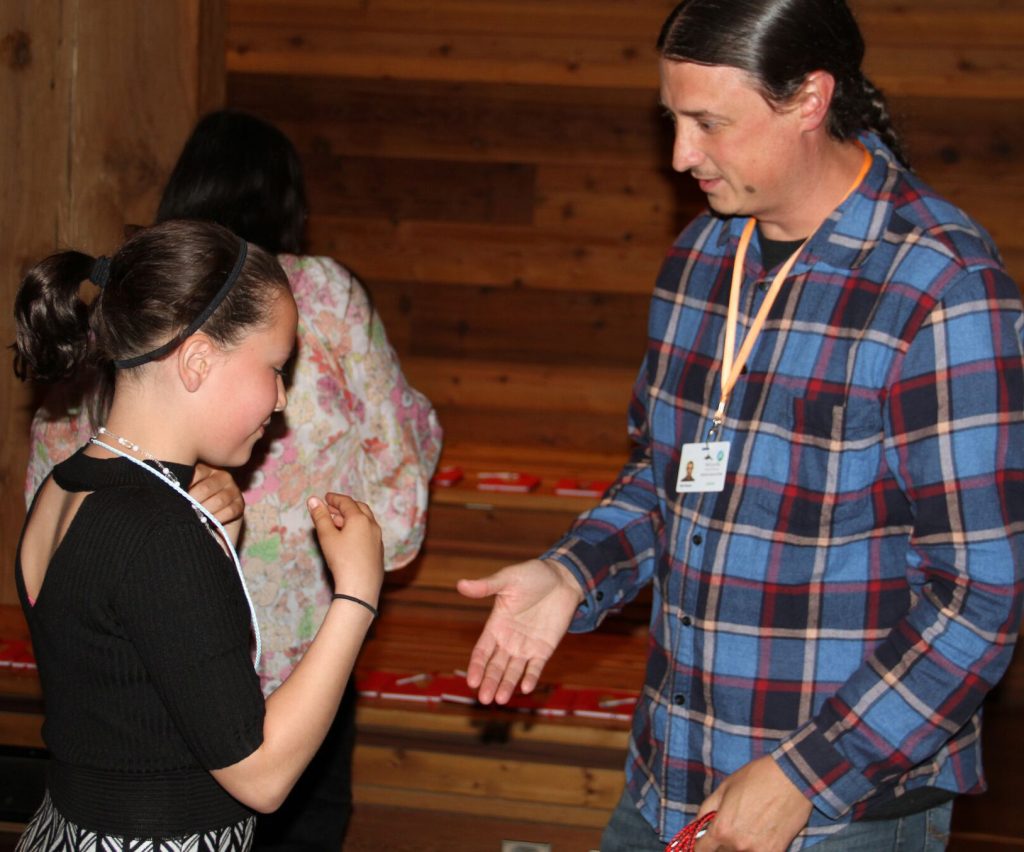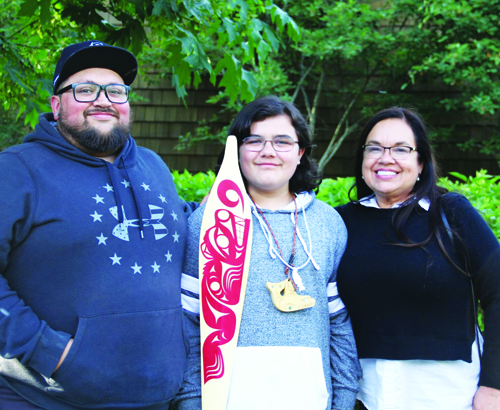Category: Education
Learning Lushootseed while exploring Canoe Journey tradition
By Micheal Rios, Tulalip News
The week of July 9-13 was full of pleasantly warm and sunny summer days in the Pacific Northwest. Inside the Kenny Moses Building, even more beams of sunshine could be found radiating from the energetic faces of 58 children participating in the 23rd Annual Lushootseed Day Camp, week one.
Open to children age five to twelve who want to learn about their culture and the language of their ancestors, Lushootseed Camp provides invaluable traditional teachings through art, songs, technology, weaving and storytelling. Each year the Lushootseed Department teams up with Cultural Resources, along with a select number of vital community volunteers, to hold two one-week day camps in the summer.
“It makes my heart happy seeing so many of our young ones learning our traditional language,” boasts Michele Balagot, Lushootseed Manager. “It is amazing to witness the amount of participation and community involvement we receive each year.”
With a high turnout in camp participation came an equally impressive turnout in community volunteers who assisted Lushootseed staff to coordinate daily camp activities. There were 15 volunteers readily available on a daily basis to help camp run smoothly.
Throughout the duration of camp, the children participated in seven different daily stations or activities. The following list is what each child accomplished throughout the week:
- Art – Succulents, clam shell rattles, clam shell succulent holders.
- Weaving – God’s Eye, bracelets.
- Songs – Paddle Song, Berry Picking Song, Welcome Song, Kenny Moses’ Arrival Song, Martha Lamont’s huyəxw st’ilib
- Traditional Teachings – Canoes, Canoe Journey protocol
- Language – Lushootseed alphabet, canoe terms.
- Technology – children learned and practiced Lushootseed materials related their final performance using handheld games on Tablets created by Dave Sienko.
Every station and daily lesson incorporated various Canoe Journey teachings and protocol verbiage. With the annual tribal Canoe Journey going on now, it made for an ideal time to teach the youngsters about the tradition.
The closing ceremony for week one’s camp took place on Friday, July 13 at the Kenny Moses Building. The joyous, young play-performers made their theatrical debut to a large community attendance, as family and friends came out in droves to show their support.
“We would like to thank the children for all of their hard work and efforts,” proclaimed Language Warrior Natosha Gobin during the play’s opening. “They attended camp for just one week and learned so much about their culture, traditions, language, and more. They do not hesitate to step up and share their teachings.
“We thank you, the parents, for joining us to celebrate the work the children have accomplished this week,” added Natosha. “Your presence here for the children will encourage their learning of their ancestral language.”
After the youth performed their rendition of “Mini Canoe Journey” and the ceremonial witnesses had shared a few words, there was a giveaway. The camp participants gave handmade crafts to each and every audience member, which preceded a buffet-style lunch featuring salmon.
Green Jobs
Submitted by Jeanne Steffener, Tulalip Tribes Higher ED
Globally, countries are very concerned with reducing imported fossil fuel use. They are searching for ways to promote the use of domestic green energy resources because of the increasing danger of climate change. Renewable energies, such as wind, solar, geothermal and bioenergy are mushrooming businesses that will thrust us into the new Green Economy. Renewable energy is extremely important because it provides big benefits for our climate, our health and our economy in these forms: minimal or no global warming emission; improved public health and environmental quality; inexhaustible energy supply; jobs and other economic benefits; stable energy prices and a more reliable energy source.
Businesses sympathetic to environmental concerns are creating a whole range of environmentally friendly jobs. We are seeing this growth evidenced in an increase of solar panel installation for businesses and houses, wind energy harnessed east of the Cascades with the windmills erected along the horizons, grocery stores are offering more organic green options throughout their stores, hybrid and electric cars becoming more mainstream. Automobile manufacturers are discontinuing inefficient gas driven models and moving toward the electric/hybrid models. We are noticing more “electric stations” in town and in our travels. This is the beginning of the green revolution. Job creation in the wind energy industry is employing full-time employees in a variety of occupations including manufacturing, project development, construction, turbine installation, operations, maintenance, transportation, logistics, financial, legal, and consulting services. There are over 500 factories in the United States manufacturing parts for wind turbines. The solar industry employs approximately 374,000 people in either full or part-time jobs, in solar manufacturing, installation, and sales and marketing positions. The renewable energy sector now includes these other forms of green energy: hydro energy, ocean energy, and bio-energy employing even more workers. Clean energy is a huge opportunity to revive manufacturing in this country. According to the U.S. Department of Energy, “3,384,834 Americans are directly employed by the clean energy industry which includes the energy efficiency, smart grid, and energy storage industries; electric power generation from renewables; renewable fuels production; and the electric, hybrid, and hydrogen-based vehicle industries”.
 In addition to creating new jobs, increasing our use of renewable energy offers other important economic development benefits. Local governments are able to collect property and income taxes from renewable energy project owners. This revenue supports public services that are vital to the community. Many of these projects are being located in rural areas where jobs are a huge need.
In addition to creating new jobs, increasing our use of renewable energy offers other important economic development benefits. Local governments are able to collect property and income taxes from renewable energy project owners. This revenue supports public services that are vital to the community. Many of these projects are being located in rural areas where jobs are a huge need.
Owners of the lands where wind projects are located receive lease payments for power line easements or road right-away. Another possibility of payment can be earning royalties based on the project’s annual revenues. Other ways that farmers can generate supplemental income is through renewable energy production by producing feedstock for biomass power facilities.
Clean energy careers involve jobs created by energy conservation, alternative energy development, pollution reduction and recycling. A number of colleges and universities are now offering specializations and degree programs in clean energy resource areas. Community colleges are a good resource for certificates and 2-year degrees offering clean energy qualifications. One of the best resources for information on renewable/clean energy education and careers is located at the U.S. Department of Energy’s website: http://energy.gov/eere/education/colleges-and-universities.
Are you interested in discovering more about the green energy revolution? Just pick up your phone and contact the Higher Education Department for more information. You can either call us at 360-716-4888 or email us at highered@tulaliptribes-nsn.gov.
A Tradition of Storytelling
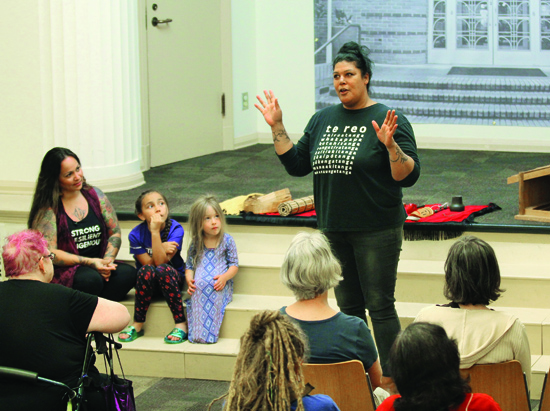
By Micheal Rios, Tulalip News
For Native Americans, the telling of stories passed down from generation to generation remains a crucial form of knowledge transfer. Oral storytelling traditions allow tribes to communicate their spiritual and historical understandings of themselves and the world they cultivated for their children and their children’s children. This all but guarantees that members of each individual tribal nation never forget their roots or lose sight of important teachings that continue a harmonious and cooperative existence with nature.
The tradition of storytelling lives on in Tulalip, where several prominent storytellers have been featured as part of a library-ran initiative to teach the general public about Native culture and to honor the Indigenous land on which they reside.
Culture bearers Michelle Myles, Natosha Gobin, and KT Jean Hots comprised a team of Tulalip storytellers who shared their craft at the Everett Public Library. The event was part of the city of Everett’s 125th anniversary celebration.
“The city of Everett, including the Everett Public Library, has been putting together a series of programs to celebrate the anniversary,” explained Mindy Van Wingen, Assistant Director Everett Library. “We wanted to include the Tulalip Tribes and honor the Native heritage of Everett and what came before the city was developed. The storytellers offered a great program. We are really happy with the attendance and the visitor engagement.”
The library’s auditorium was filled to capacity with eager listeners willing to explore local history from the Tulalip Tribes’ perspective, while learning about a vibrant culture and community.
“We were invited to share traditional stories from our area and ancestors,” said Natosha Gobin, Lushootseed Teacher. “We shared oral history and helped the listeners gain a better understanding of the life ways of Coast Salish people.
“Storytelling is significant because that is how all of the teachings were passed on, from the elders to children through oral teachings, and those teachings were passed on daily. We didn’t have a written language until the late 1960s, so storytelling is how everything that makes us who we are was passed on.”

Natosha and Michelle took turns sharing traditional stories, such as The Seal Hunting Brothers, The Gossiping Clams, The Basket Lady, and A Story About Coyote. In each story were lessons learned about living in a good way, instructional survival skills, and even explanations for natural phenomena.
At one point, storyteller apprentice, nine-year-old tribal member KT took center stage and shared the story Her First Basket. After finishing her favorite story, KT received a loud applause from the audience.
“I think it’s important for kids to learn to tell stories. They can learn and go home and teach their parents and brothers and sisters,” shared KT after her storytelling session. “Kids can learn our culture and Lushootseed and help teach it. Family or friends can help you like the cedar tree helped the little girl in Her First Basket.”
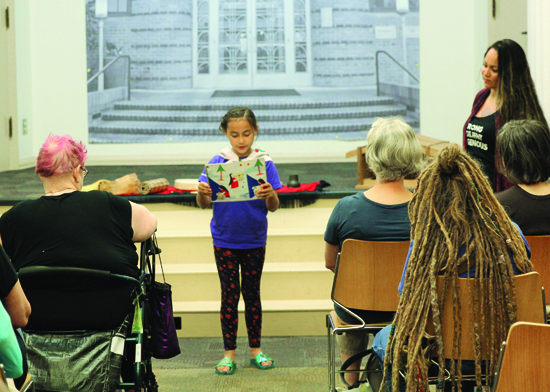
Native American storytelling has always been and continues to be equal parts real, metaphorical, spiritual, instructional and transformational. Most of all, however, the stories are entertaining and memorable to the audiences who hear them. This way the stories are remembered and passed down to the coming generations, who needs to understand who they are, where they come from, and why the world is the way it is.
“Storytelling means being the example, being the one that kids can look up to and ask questions to,” explained tribal member artist and storyteller Ty Juvinel. “Having a story to tell children, instead of yelling or chastising when they’ve done something wrong allows them to learn in a good way. From stories they learn the values of their people and how to present themselves.”
Ty has recently partnered with the Seattle Public Library system and will be sharing Coast Salish stories and tradition through the summer. Intended for kids ages 7-11, there is no registration required for families to bring their kids to a Ty story time.

Using modern technology, Ty has fully illustrated and digitized several of his stories for use on an iPad. Of note, the University of Washington has purchased his digital stories to be used in their travelling exhibits and Burke Mobile for educating people on Coast Salish culture.
Seattle’s Broadview Branch was the latest to host the storytelling series. Children were treated to several original stories, including How Mouse Moved the Mountain, When Beaver Taught Man, and How Puppy Got His Ears.
“I loved it!” remarked Irene Haines, Librarian and enrolled member with Confederated Tribes of the Colville Reservation. “Ty did a wonderful job of being patient with the kids and speaking to them in their own language. There’s such a wealth of art and culture to be shared.”
Although the tradition of storytelling is less common today than it was many years ago, the rich oral tradition lives on through the current generation of culture bearers.
Family Wage jobs
Submitted by Jeanne Stiffener, Tulalip Tribes Higher ED
If you are working a couple of jobs just to put food on the table and a roof over your head for you and your family, try looking at a Family Wage Job that can give you more security. A family wage according to Wikipedia is, “a wage that is sufficient to raise a family. This contrasts with a living wage, which is generally taken to mean a wage sufficient for a single individual to live on, but not necessarily sufficient to also support a family.”
Take a look at Union Jobs which come with many benefits: Collective Bargaining; Higher Wages; Support; A Voice; Equality and Fairness; Job Security, A Stronger Economy; Better Training, Health and Safety and Rewards and Benefits.
If school isn’t your thing then look at the training that Unions offer. There are many benefits to joining a Union. Unions provide a way in which you can negotiate working conditions such as pay, benefits and retirement collectively as a group. This is in sharp contrast to doing it on your own. Union appreticeship programs provide you with the skills you need to get started in construction or manufacturing industries. Administration or professional positions are available at every level of federal state and local government.
 Collective Bargaining – Collective bargaining occurs when a group of people, such as the workforce of a company bands together to increase its negotiating power. This lets the voices of individual workers be heard. Typically, union workers elect representatives to bring their concerns to the union’s attention. Collective bargaining makes sure the changes are negotiated rather than imposed.
Collective Bargaining – Collective bargaining occurs when a group of people, such as the workforce of a company bands together to increase its negotiating power. This lets the voices of individual workers be heard. Typically, union workers elect representatives to bring their concerns to the union’s attention. Collective bargaining makes sure the changes are negotiated rather than imposed.
Higher Wages and Benefits – One of the top benefits of being a union worker are the higher wages compared to non-union workers. Union workers are also more likely to have wage increases on a regular basis. Union wages are about 10–20% higher than non-union jobs. Pensions, medical insurance, paid vacation, holidays, personal holidays, sick pay overtime premiums, shift differentials, etc. are not only better in a union shop but in many instances, these benefits would not even exist without a union contract.
Support – One of the key benefits of working as a union employee comes when you have a personal issue with your employer. The union representative works with you and your employer to negotiate a good outcome for you. Unions are important supporters of human rights and democracy. They provide workplace representation for their members, have some influence over workplace rules and provide protection from random discipline and dismissal.
A Voice – Good workplace relations are a positive. When people feel that they are treated with dignity and respect; when the workplace rules are perceived as fair; when workers can raise their concerns and have them fairly resolved; when workers know that they share in the benefits of workplace change; and when workers have a say in working conditions, training, and health and safety issues – then workers are more likely to work co-operatively with management.
Equity and fairness – Collective bargaining Agreements reflect economic realities and the desire of unions to retain good jobs for all their members. Unions have been an important defender of human rights and economic equality.
Job Security and Better Training – Unionized workplaces tend to have far lower worker turnover. This gives the employer the benefit of having experienced workers. This creates an incentive for employers to invest in the skills of employees knowing that they are less likely to leave the company.
Women in the Workplace – Women have made many strides and currently they make up 48% of the workforce. Unions advocate for policies that promote a full-employment economy at wages high enough to allow working women to support their families. Unions reject the status quo and are working to build an economy where all working people can support their families and achieve their dreams.
Union Jobs – There are union members in almost every employment sector: blue collar skilled trades, factory workers, civil service administrative and management employees, professionals working in higher eduation, healthcare, and government. The public sector has the highest percentage of union workers (corrections officers, firefighters, police, and fire inspetors). Also unionized are these sectors of the economy: Transportation, Telecommunications, Construction, Educational Services (elemementary, middle, and secondary school teachers and administrators, including teacher assistants), Motion Pictures & Sound Recording and Manufacturing
Are you are interested in a life changing opportunity? Check out the Unions in your field of expertise. You can contact Higher ED staff at 360-716-4888 or email us at highered@tulaliptribes-nsn.gov.
23rd Annual Lushootseed Language Camp, July 9-13 and July 16-20
Tulalip Tribes celebrates 2018 graduates
On the evening of June 12, Tulalip Resort’s Orca Ballroom was home to hopes and dreams aplenty as the graduating class of 2018 was recognized with a graduation banquet. In all there were seventy-four high school graduates and forty-eight higher education graduates who, accompanied by their proud families and friends, convened to commemorate the rite of passage.
There was entertainment, a catered buffet-style dinner, and plenty of motivational words offered from their peers and elders reminding the graduates this is just the first step on the path to success.
“It is a privilege and an honor to be here with you all on this special night where we come together and celebrate the academic achievement of our young ones,” stated Board of Director Mel Sheldon, banquet emcee. “We are so proud of each and every one of our graduates for their commitment to education. We thank the parents, grandparents, extended family, and all the school faculty who were always there for the students and made it possible for them to be here today.”
Graduating high school senior Keryn Parks, along with higher education graduates Kaeli Grenier-Moses and Marci Fryberg Johnson each took to the stage and offered encouraging words to fellow graduates. They reminisced over their favorite school experiences, spoke of hardships overcome, thanked their families and Tulalip community for always supporting them, and shared their excitement for great things yet to come.
“It’s an honor to speak on behalf of Tulalip Heritage and the entire graduating class of 2018,” said Keryn. “The road to graduation may have been easy for some, but has been difficult for others. Our class was dealt with the heaviest card any freshmen class could go through. There were setbacks, breakdowns, a lot of pain, and a community separated. Yet, through all that we found strength and healing that brought us closer. Class of 2018, never doubt how far you can go, but most importantly don’t ever forget what you have accomplished.”
Marci, representing the higher education graduates, shared details from her fifteen year journey to earn a Bachelor’s Degree. “Being educated has been instilled in me since I was a little girl. Having an education allows for us to move beyond the ignorance we will encounter in the world, and to stand tall and represent our Native people in a good way.”
Nikkita Oliver, activist, educator, lawyer and spoken word artist, provided a truly memorable keynote speech that left many in the crowd feeling inspired. She is a University of Washington graduate who has committed herself to empowering others to reach for goals larger than themselves.
“Being here, at a gradation, is something very powerful. For our peoples, rites of passage are something that we’ve been going through for a long time. Maybe it didn’t always look like a graduation from a school, but we’ve long celebrated what it means to complete a season in our life and to celebrate the lessons and knowledge we have gained,” explained Nikkita, former city of Seattle mayoral candidate. “Look around this room. I was told there are a thousand people in here. There are seventy high school graduation and forty college graduates, and somehow that adds up to a thousand people.
“Dream what you want to have with these thousand people. Dream about who you want to be with these thousand people. That’s far more important than what your next step is tomorrow because what that vision will do is become your guiding principle. It’ll become the way you think about the world and become the way that you think about yourself.
“No matter what statistics say about you, no matter what stories society tries to tell about you, you should always dig deep into your own history. Look to the perseverance of your own people, to the resilience that’s already been set before you and understand that you can push through any obstacle.”
Following the inspiration keynote speech a special recognition ceremony was held to honor the Tulalip Tribes senior boy and girl student of the year.
Keryn Parks, a graduate of Tulalip Heritage High School, received the female student of the year honor. Having overcome adversity and hardship early on as a freshman, Keryn went on to be a tribal youth representative, active ASB participant, and two sport athlete in basketball and volleyball, all while maintaining a high G.P.A. and taking college classes through Running Start.
Coby Nelson, a graduate of Marysville Pilchuck High School, received the male student of the year honor. Coby balanced his academic course load with playing varsity golf, tennis, and baseball. One teacher said, “As with all families the children are called upon to take responsibilities and help out with the task of family life. I’ve observed this young man helping his family, taking on adult responsibilities, and volunteering to help many of his peers at school. He’s a polite and humble young man.” Another teacher said, “He’s one of the most caring young adults that I know. He has a kind heart and shows so much compassion for those younger and less fortunate than himself.” Coby plans to attend Washington State University in the fall.
Concluding the evening’s celebration, former youth council chairwoman Jlynn Joseph shared, “This was a very emotional event for my family. We’ve worked so hard to keep me on my path to academic success. I will be the first in my immediate family to have graduated on time from high school. My great grandma, the late Loretta James, has inspired me so much and has been my driving force to give back to my community and to use my future degree to take care of the people.” Jlynn excelled at Bishop Blanchet High School, a private school in Seattle, and will be continuing her education at Arizona State University in the fall.
Congratulations to all those Tulalip students who put in the hard work and dedication to earn their graduate status. Chasing a dream requires your efforts and passion. The hard work isn’t over now that you have graduated, it’s only the beginning as you now prepare for the new challenges waiting in the next chapter of life. Good luck and congratulations!
Building a better future with Tulalip’s construction career program
By Micheal Rios, Tulalip News
Educators, parents and others often place emphasis on college preparation and earning an Associate or Bachelor’s degree by traditional means. But some students see a more hands-on future for themselves. For those unafraid of getting their hands dirty and learning the true meaning behind a hard day’s work there are ample opportunities available within the construction industry.
In fact, look around the Seattle area and you’ll see more cranes than you can count. While other career pathways may be oversaturated and hard to come by, the construction trades are booming. According to the U.S. Department of Labor, open construction positions are expected to increase by more than 745,000 jobs nationally through 2026, a faster growth than any other occupation. In Washington State alone, there are already more than 3,200 unfilled construction jobs, of which many pay more than the average state wage of $54,000 a year.
Whether it be laborer, carpenter, ironworker or heavy equipment operator, there are countless openings for work and advancement within construction trades, especially for sought after minorities, like Native Americans and women. A major access point for entry into the construction trades for tribal citizens and their families continues to be Tulalip’s own TERO Vocational Training Center (TVTC).
On Wednesday, May 30, eighteen TVTC students were honored with a graduation banquet for their commitment to building a better future. Over 200 guests attended, including several Board of Directors, trade union representatives, and many cheerful friends and family members of the graduates.
Of this latest graduating cohort, nine students are Tulalip tribal members, two are children of tribal members, and seven are other Native. Three hardworking ladies were among the graduates; Sela Kalama (Quinault), Verla Wapato (Yakama) and Pamela Dick (Colville). The desire to build a new skillset while creating new career pathways was the main motivator, as each of these three women left their home and children in order to reside within the Tulalip area for the duration of the intensive, sixteen-week pre-apprenticeship construction trades program
As far as we know, the TVTC program, which is managed by the Tulalip TERO, is the first and only state and nationally recognized Native American pre-apprenticeship program in the country. The program is accredited through South Seattle Community College and Renton Technical College, while all the in-class, hands-on curriculum has been formally approved by the Washington State Apprentice and Training Council.
The sixteen-week program provides 501-hours of hands on instruction, strength building exercise, and construction skills that can last a lifetime. In addition, students are trained and awarded certifications in flagging, first aid/CPR, and OSHA 10-hour safety training. Also, students receive certification in the scissor lift, boom lift, industrial fork lift, and powder-actuated tools. Upon completion, each graduate’s diligent training is rewarded with a wide-range of new employment opportunities as they navigate the construction trades career path.
“I took this class to better my work experience, gain new skills, and become more comfortable with interviews,” said Tulalip tribal member and now TVTC graduate, Izzy Wolftail. “My favorite part of the TVTC experience was making new friends from different tribes and working side-by-side with them to complete our tiny home project. I plan on bettering my future and the Tribe with my new skills.”
TVTC pre-apprenticeship is a unique, nationally known model that supports tribal members from sovereign nations across the United States. The program is not dependent on tribal hard dollars. In fact, zero hard dollars are used to fund it. Instead, due to the dedication and commitment of so many individuals the TVTC program continues to grow and gain more recognition while being funded by the graciousness of the Tulalip Charitable Fund and W.K. Kellogg Foundation.
“This particular group of students was just tremendous,” described instructor Mark Newland during the graduation ceremony. “They came prepared and ready to work every single day. Each student was eager to learn and they worked really well with one another. It was a pleasure being their instructor.”
Under the supervision of Mark and co-instructor Billy Burchett, spring quarter students constructed four tiny homes as their final class project. These houses, which are approximately 120-square-feet in size, are the first batch of tiny homes that will be staying on the reservation, with plans for them to provide shelter for homeless tribal members. The insulated houses will be a major upgrade for their soon-to-be residents as they offer electricity, heat, and, most importantly, a measure of stability.
“Tulalip Tribes Board of Directors requested this TVTC cohort build the first four tiny houses for the Tribe. The Board provided the materials and the class built the houses,” explained Lynne Bansemer, TERO Coordinator. “According to instructor Mark Newland these were the best home that have been built to date by our students. We feel the reason is because they were built with love. Bringing this home has meant so much for the TERO and TVTC staff, but our students knew they were building for potential family and friends. What a difference this made!”
Beyond construction skills, several students, who are also tribal members, reached major milestones during the pre-apprenticeship program. Quinton Hill retrieved his driver’s license, while Carter Paul and Hayden Cepa both put in the work necessary to be awarded their high school diploma.
“For persons on the path to recovery, we have seen them find success during their time as TVTC students and beyond,” added Lynne. “This program introduces them to so many new experiences, shows them their unique individual strengths, and builds their confidence to new heights. We have had families reunited and people find the success they have hoped for because they are able to see daily how strong and capable they are.”
For more information on Tulalip TERO’s TVTC program or to inquire about admission into the next pre-apprenticeship opportunity, please contact Lynne Bansemer, TERO Coordinator, at 360-716-4746 or visit TVTC.TulalipTERO.com
MSD traditionally honors 5th grade native students
By Kalvin Valdillez, Tulalip News
The Marysville School District (MSD) Indian Education Department held a ceremony at the Hibulb Cultural Center Longhouse on the evening of May 31, to honor their fifth-grade students who will be making the transition from elementary to junior high next fall. Native students from the Allen Creek, Cascade Grove, Liberty, Marshall, Kellogg Marsh, Marysville Co-Op, Shoultes and Sunnyside elementary schools were recognized for successfully completing grade school and beginning the next phase of their educational journey.
The traditional graduation ceremony was inspired by the Quil Ceda Tulalip fifth grade potlatch that is held at the end of every school year. MSD native liaisons were motivated to create a similar ceremony to honor the native students who attended other elementary schools throughout the district. During the ceremony, the students are gifted necklaces with cedar-carved salmon pendants and are offered words of support and encouragement from Tulalip tribal leaders.
“Students, you hit a milestone on going into a new school,” expressed Tulalip Vice-Chair Woman, Teri Gobin. “You’ve taken a step into a new direction and it’s going to be a wonderful. Next thing you know you’ll be going into high school and then graduating. We look forward to doing anything we can to assist you. I want to encourage you to take advantage of the native liaisons to help you through every step. We’re proud of each and every one of you.”
The ceremony also serves as a means of introduction between students who will be attending the same middle school but attended different elementary schools; as well as between students and the native liaisons of their new school.
“We came together as a team to honor the fifth graders as they go to middle school,” said Native Liaison, Zee Jimicum. “It’s a tough transition. Quil Ceda Tulalip Elementary has a fifth-grade transition weekly course to help their students prepare for middle school. So for those kids who don’t have that connection like Quil Ceda Tulalip students, it’s super important that they see our faces so when they get to middle school next year they have that connection.”
MSD native liaisons Terrance Sabbas and Matt Remle performed an honor song for the students on the traditional round drum and presented them with cedar necklaces. Each liaison also introduced themselves and shared their excitement with the future middle schoolers.
“As a district we wanted to honor, encourage and support these students culturally here in the longhouse,” said Terrance. “We wanted to sing our traditional songs so they can feel at home. We wanted to tie it all together with culture and honor all the work they’ve accomplished.”
The MSD Indian Education Department also thanked Cascade Elementary Principal, Teresa Iyall Williams, for her years of dedication to the youth as she’ll be enjoying the retired life after this school year. Teresa was blanketed by the Indian Education Department and referred to as an ‘inspiration to all the young native girls’ and ‘a great example of how to conduct yourself’ by Tribal member, Denise Hatch-Anderson.
The students received journals from the MSD Indian Education Department so they can document the next three years of their middle school experience.
“The excitement you have, I hope it continues all the way until you graduate from high school and from college. Whatever you choose to do in this world, we ask you to dream big,” said Deborah Parker, MSD Director of Equity, Diversity and Indian Education.
Dreaming big is exactly what the students plan to do, including Tulalip tribal member Conner Juvinel, who plans to continue pursuing his passion during his middle school years.
“I dream to become a scientist,” he states. “I enjoy science a lot, like earth studies. It feels terrifying but still pretty awesome to go into middle school. I don’t know what I’m most excited about but I know I’m excited.”
Measuring the Value of Education
Submitted by Jeanne Steffener, Higher ED
Everyone wants to make sure that their time and money are well spent. This is also true of dollars spent in pursuit of higher education. Today students attend college for a variety of reasons. Students enroll in degree or certificate programs while others strive to obtain vocational skills. Whatever your reason for attending school, you want to make sure that you are getting your money’s worth.
But how do we measure the value of education? The value lies in the purpose of education which is … to make it possible for individuals to realize their potential as human beings and as citizens of their society and their world. G.K. Chesterton once said that: “Education is simply the soul of society as it passes from one generation to another.”
Education is really an investment in your life and your community’s life and the more time you invest in it, eventually it will translate into a greater return. Like stocks, you cannot judge the rate of return in the short term. It is over the long-haul that we can accurately determine how our education has opened up opportunities for us that would have been impossible without that degree. A college degree gives a person the opportunity to enjoy knowledge, better job opportunities, increased health benefits, tax benefits, life changing friendships and satisfaction with life.
Generally speaking, a college degree promises a certain level of knowledge gained. It implies that a college educated person has completed all the required coursework for a particular field of study. Employers, therefore, have confidence that a future degreed employee has the working knowledge of business and the ability to cope in a competitive work environment. The skill set developed by such a person is also greater than someone without a college education. Some of the key aspects of education gained are problem solving, creative thinking, social skills, evaluation, empathy, communication and reasoning skills to meet the challenges of life. If you think of education as preparation, you will have an incredible resource for life.
With the advantage of attending college/university, students open up their chances of expanding their minds. In the process of meeting and befriending people of all walks of life and cultures, students begin to accept and appreciate people for who they really are. Eventually, stereotypes and discrimination fade from of their lives. This is why a college education is so important and how it plays a huge part in opening up a person’s mind.
We see the significance of friendships and how these relationships are developed in a large network of acquaintances. Some of these people will share a strong bond with you for the rest of your life. These friendships may open up career opportunities in the future. Friendships become a significant benefit of college life.
Earning a college degree opens up doors to greater opportunities and possibilities. This is rite of passage which helps individuals to develop self-confidence and grow as human beings. Most people believe that the more education you receive helps you to develop your mind and in the process opens up the potential to change your life.
In the backlash against college, surveys have been taken that show that an overwhelming number of participants felt that a post-secondary education is more than just a paycheck. Education does many things but more importantly it empowers a person to think, question, and see beyond the obvious. Education broadens our horizons and gives us a better understanding of the world around us and how it works. Education will help you to realize your potential and allow you to reach for the sky.
Are you are interested in a life changing opportunity? Higher ED can help discover what it takes go to college. You can contact Higher ED staff at 360-716-4888 or email us at highered@tulaliptribes-nsn.gov.

